EDWARD SUTLIEFF
Subject Name: Edward Sutlieff (b1838 – d1897)
Researcher : Steve Kirk
Edward Sutlieff, following the tragic loss of both parents, became isolated from the rest of his family, seemingly wandering the streets for years before ending his days in the Guildford Union Workhouse.
Edward, officially registered as ‘Edward George Sutcliffe’, was born on 29th December 1838  in St Mary’s, Guildford, the seventh child of Joseph, a shoemaker, and Maria, née Freakes.
in St Mary’s, Guildford, the seventh child of Joseph, a shoemaker, and Maria, née Freakes.
Edward was given a Non-Conformist baptism on an unspecified date as part of a non-Parochial community called Irvingite, also known as the Catholic Apostolic Church, which was a Protestant sect formed by Scottish preacher, Edward Irving. Local MP Henry Drummond was a devotee of Irving, with congregations initially gathering at his Albury Park home, just outside Guildford. This is where Edward’s baptism was most probably held. Edward’s sisters Naomi Maria, Maria and Rebecca were also baptised into the Irvingite sect, although his other siblings were not. Drummond had a church built for the ever-growing congregation in his grounds in 1840. The church still stands there today, although unused.
The 1841 Census showed 2-year-old Edward living with his family at Angel Gate, Guildford, a 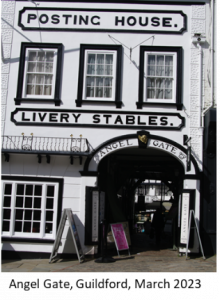 cobbled thoroughfare which looks today very much as it did then.
cobbled thoroughfare which looks today very much as it did then.
Edward’s father Joseph, age 39, was a cordwainer (shoemaker) and would almost certainly have worked here. Mother Maria was 34, with Edward’s five siblings being Thomas (11), Josiah James (9), Arthur Charles (7), Maria (5) and Jane (2 months).
No records have been found to show further births following Jane, however, Edward’s mother did become pregnant seven years later in 1848. For whatever reason, Maria, now into her 40s, had an abortion around 14th August. This was a highly illegal procedure at that time, with severe punishment including potential life sentences for those involved. It was only in 1837 that the ‘Offences Against the Person Act’ abolished the death penalty for abortion, in favour of imprisonment or transportation. The abortion was to prove fatal for Maria, as she died eleven days later on 25th August in Guildford from ‘phlegmonous erysipelas’, a bacterial infection, age 41.
Edward was just nine years old and his sister Jane seven. The tragedy of their mother’s death would have left his father Joseph in the difficult position of trying to work and raise his family. His problem was borne out by the 1851 Census, which showed Joseph, 48, as a widower cordwainer ‘receiving parish relief’. 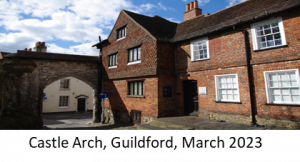 It is not clear whether Joseph was actually working. The family were now living at 4 Castle Arch, Guildford, just a few hundred metres from their previous home. Joseph’s oldest son Thomas, 19, was an apprentice bricklayer and Josiah, 17, an errand boy. Edward, 10, Maria, 13, and Jane, 8, were all noted as scholars. Why all Joseph’s children’s ages were two years under what they really were is not known. Third son Arthur had moved out, probably listed as Arthur Sutcliffe, a servant on Park Farm at nearby Artington.
It is not clear whether Joseph was actually working. The family were now living at 4 Castle Arch, Guildford, just a few hundred metres from their previous home. Joseph’s oldest son Thomas, 19, was an apprentice bricklayer and Josiah, 17, an errand boy. Edward, 10, Maria, 13, and Jane, 8, were all noted as scholars. Why all Joseph’s children’s ages were two years under what they really were is not known. Third son Arthur had moved out, probably listed as Arthur Sutcliffe, a servant on Park Farm at nearby Artington.
Further tragedy followed just two years later when on 9th April 1853, Joseph committed suicide at the family home in Castle Arch, age 51. The death certificate noted the verdict of the Deputy Coroner for the Borough of Guildford that Joseph had ‘hung himself while insane’. Edward was now 14 and would likely have been in employment. It’s not known if he and any other members of the family were living at Castle Arch at the time.
Edward’s younger sister Jane received a six-week prison sentence in December 1858 for stealing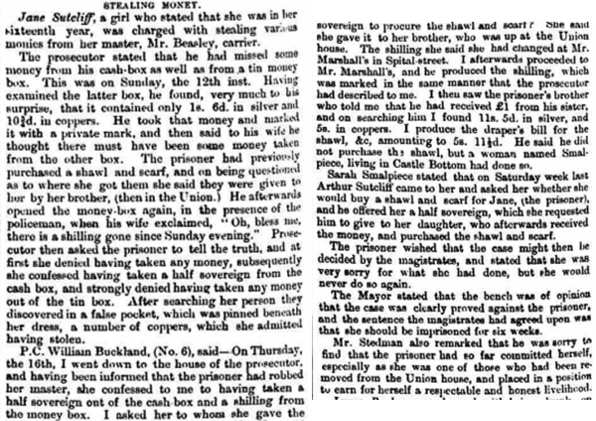 money from her employer. The detailed newspaper report said that she had been placed in her position of work from the Guildford Union.
money from her employer. The detailed newspaper report said that she had been placed in her position of work from the Guildford Union.
Generally, a child would leave the workhouse around the age of 14 when old enough to enter employment. It is likely that Jane would have been in the Workhouse from around the time of or just after her father’s death until that age. Edward also could have been there too and received help from the Union to find employment, but no records exist to prove this. The same newspaper report remarked that older brother Arthur was ‘up at the Union house’ when Jane was charged in 1858.
The next record traced for Edward is the 1861 Census, showing him as an unmarried 20-year-old (actually 22) lodging in Bridge Road, East Moseley with the family of a builder. Edward’s occupation was noted as an engine cleaner, most probably at the Hampton Court Railway Station terminus just a few minutes walk away. The job involved climbing inside the steam engine’s boiler to remove the ash, a difficult and extremely unpleasant task.
What happened to Edward over the next decade or so is unclear. All of his siblings had already settled down or would do so by the time of the 1871 Census, but this did not happen for him, with no trace of him found in that Census.
It is not until the West Surrey Times of 19th September 1874 that Edward’s name appears again,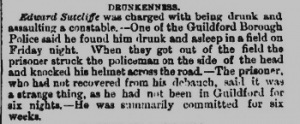 reporting that he had received a six-week prison sentence in Wandsworth Gaol. The article said that a policeman had found Edward drunk and sleeping in a Guildford field. Sleeping rough in itself was an offence at that time, but Edward made matters worse when he ‘struck the policeman on the side of the head and knocked his helmet across the road’. His Wandsworth Gaol record described him as a 34-year-old labourer, 5 feet 3 inches (1.60m) tall with a fresh complexion, brown hair and eyes, scars on his right eyebrow and left thigh and warts on the back of his right hand. His weight was 8 stone 9 pounds (55 kg) on admission on 14th September 1874, dropping five pounds (2.3 kg) during his six weeks imprisonment there.
reporting that he had received a six-week prison sentence in Wandsworth Gaol. The article said that a policeman had found Edward drunk and sleeping in a Guildford field. Sleeping rough in itself was an offence at that time, but Edward made matters worse when he ‘struck the policeman on the side of the head and knocked his helmet across the road’. His Wandsworth Gaol record described him as a 34-year-old labourer, 5 feet 3 inches (1.60m) tall with a fresh complexion, brown hair and eyes, scars on his right eyebrow and left thigh and warts on the back of his right hand. His weight was 8 stone 9 pounds (55 kg) on admission on 14th September 1874, dropping five pounds (2.3 kg) during his six weeks imprisonment there.
It appears that Edward may have been a vagrant for some time, as four years later in October 1878, 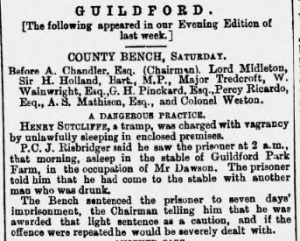 he was again imprisoned in Wandsworth Gaol for sleeping rough. Now 39, he received a seven-day sentence after a policeman found Edward (mistakenly called Henry in the newspaper) sleeping in a farm outbuilding on October 12th. The prison record noted that he had three previous convictions. The newspaper refers to him as ‘a tramp’, which might explain why there is no record of him in the 1871 census.
he was again imprisoned in Wandsworth Gaol for sleeping rough. Now 39, he received a seven-day sentence after a policeman found Edward (mistakenly called Henry in the newspaper) sleeping in a farm outbuilding on October 12th. The prison record noted that he had three previous convictions. The newspaper refers to him as ‘a tramp’, which might explain why there is no record of him in the 1871 census.
The 1881 Census showed Edward to be an inmate at the Guildford Union Workhouse, described as a 42-year-old unmarried ‘labour in Iron Works’ . The Filmer and Mason Iron Foundry in Millbrook, Guildford, now the site of the Yvonne Arnaud Theatre, was a thriving business at that time so it is possible that Edward was telling the truth and was employed.
There are no records to show when Edward entered or left the Guildford Union. He was not there at the time of the 1891 Census, and cannot be found elsewhere in that census, indicating that he may have continued to live as an itinerant. In fact, Edward is not traced again until his death back in the Guildford Union on 31st October 1897, age 57. Noted as a general labourer from Stoke-within-Guildford, he had been suffering from ‘chronic phthisis’, another name for tuberculosis, for ‘many years’.
March 2023
Sources
Alburychurches.org
Alburyhistory.org.uk
Ancestry.co.uk
Britishjournalofmidwifery.com
British Newspaper Archive
Centrepoint.org.uk
FindMyPast.co.uk
General Register Office Gov.co.uk
Legislation.gov.uk
Surrey History Centre, Woking Surreycc.gov.uk
Timeline-World History
Wikipedia.org
Workhouses.org.uk
For a full list of references click here
